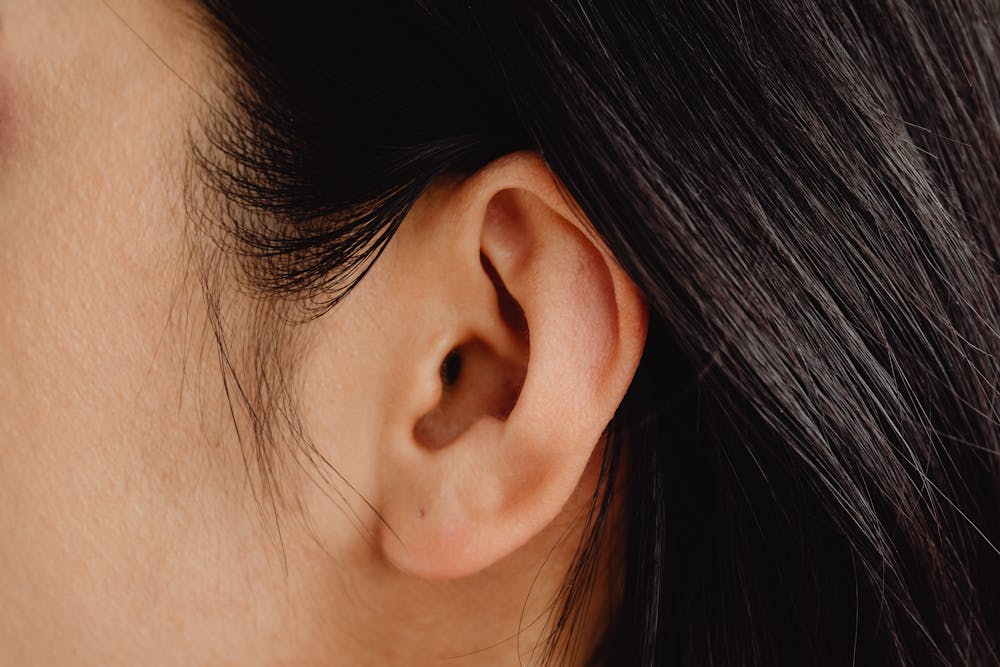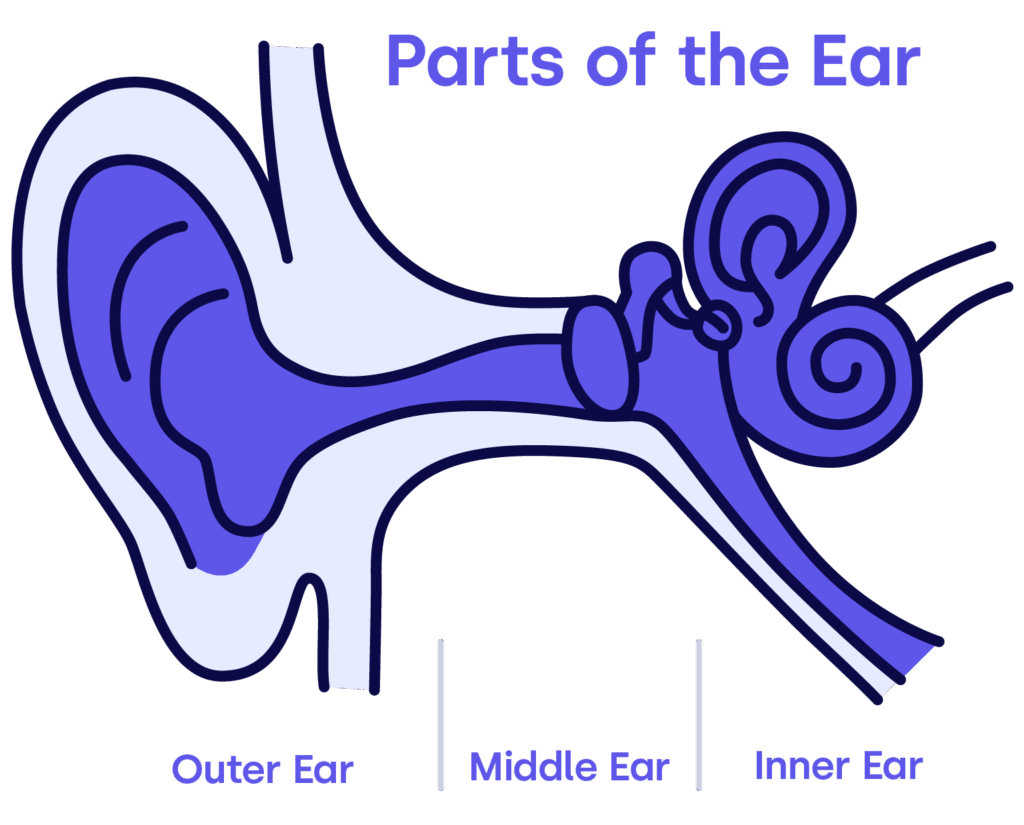How hearing works: A simple guide to ear anatomy
Ever wondered how you actually hear sound? Let’s explore one of our most interesting senses.
 A close up of an ear
A close up of an ear
Hearing is a complex sense that many take for granted. It is, after all, an essential part of our ability to communicate and feel connected to the world around us. But the mechanics of hearing are a lot more complicated than you might think, and understanding hearing is crucial as you navigate the complexities of hearing loss and hearing health.
While you may think you understand what sound is, it’s important to know how sound works and how our minds process it. Sound is actually the sensation of hearing. Each sound is made up of waves of vibrating particles that travel through matter, typically gas (or air). For sounds to eventually reach the brain, they must first reach the ear.
The ear consists of three parts, which work together to produce hearing: the outer ear, the middle ear, and the inner ear.
The 3 key takeaways
- Sound is a vibration that travels through the air – It’s then picked up by the ear and travels through the various parts of the organ.
- The ear consists of three parts: outer, middle, and inner – Each works together to produce what we hear as sound.
- Auditory processing occurs in the brain – It takes place within the brain’s temporal lobe, helping us filter background noise and effectively communicate.
Parts of the ear
The ear is a small organ with a mighty job. Its various parts are important in how sound begins at its source and eventually reaches our brains, where sound is perceived.
The ear consists of three parts:
- The outer ear. Mainly responsible for capturing vibrations and funneling them down to the middle ear.
- The middle ear. Responsible for amplifying the vibrations and carrying them to the inner ear.
- The inner ear. Helps to convert the sound waves into electrical impulses.
Let’s take a closer look at how each part of the ear functions.
Outer ear
The outer ear consists of three parts: the pinna (or the part that is easy to visualize on the side of the head), the ear canal, and the eardrum. The curves of the pinna collect sound and help with determining which direction sound is coming from and how far or close it may be from the listener.
The pinna funnels sound down a narrow channel called the ear canal, where it eventually meets the eardrum. The eardrum ( also called the tympanic membrane) is a small, thin membrane that forms a barrier between the outer and middle ear.
When sound waves vibrate the tympanic membrane, this also vibrates the middle ear.
Middle ear
The middle ear consists of the ossicles and the eustachian tube. The ossicles are the three smallest bones in the body: the malleus, the incus, and the stapes.
When the ossicles are set in motion by vibrations from the eardrum, they amplify the sound waves, transmitting them through part of the inner ear. Although the eustachian tube doesn’t actively transmit sound, it helps equalize pressure in the ear.
If the eustachian tube isn’t functioning properly, it can lead to a buildup of fluid in the middle ear space, ear infections, and pain or discomfort.
Inner ear
The stapes, the end of the ossicular chain, moves sound waves through a part of the inner ear called the oval window. The oval window is a membrane located at the end of the middle ear and at the entrance of the inner ear.
The inner ear, called the cochlea, is a snail-shell-shaped organ filled with fluid and tiny hair cells. When the sound waves enter the inner ear and move the fluid, this moves the hair cells.
The hair cells then convert the sound waves into electrical impulses. Nerve cells called neurons carry electrical activity to the brain through the eighth cranial nerve.
How hearing works step-by-step
Step 1: Sound wave collection – The outer ear (pinna) captures sound waves.
Step 2: Sound wave travel – The waves move through the ear canal to the eardrum.
Step 3: Vibration of the eardrum – The eardrum vibrates in response to the waves.
Step 4: Movement of ossicles – Three small bones (malleus, incus, stapes) amplify and transmit the vibrations to the cochlea.
Step 5: Conversion to neural signals – The cochlea’s hair cells convert vibrations into electrical impulses.
Step 6: Interpretation by the brain – The auditory nerve sends impulses to the auditory cortex for processing.
Common causes of hearing loss
It’s impossible to diagnose every instance of hearing loss in a single article.
However, there are a few common causes of hearing loss.
Aging
The inner ear hair cells can break down over time, resulting in hearing loss, as less auditory activity is sent to the brain.
Noise exposure
Loud noises, whether brief or constant, can cause physical damage to the inner ear hair cells, resulting in hearing loss.
Middle ear fluid
Fluid in the middle ear space, which is typically filled with air, can temporarily prevent sound transmission. Untreated fluid also puts you at higher risk for permanent hearing damage.
Impacted cerumen (or earwax)
Earwax can form a block in the ear canal, preventing sound waves from traveling down the canal and through the eardrum.
Ear trauma
Trauma, such as a perforated eardrum, can cause temporary or permanent hearing loss. Damage to the eardrum or sections of the inner ear can occur from slapping or hitting your ear or head.
Disease
Illnesses such as Ménière’s disease, an inner ear disease, can cause balance issues, vertigo, and hearing loss. Other hearing loss-related diseases also include otosclerosis, which causes additional bone growth around the stapes, and auditory neuropathy spectrum disorder, which interrupts sound interpretation to the brain.
Medication
Many medications can have temporary or permanent hearing loss as one of their side effects. For example, loop diuretics like Lasix are known to cause cochlear damage, and opioids such as Vicodin can cause hearing and balance issues.
How to know if you’re experiencing hearing loss
There are many symptoms of hearing loss. Symptoms often depend on how severe the hearing loss is, and they might not be as obvious in earlier stages of loss. Not everyone experiences all symptoms of hearing loss, either.
Some of the most common symptoms of hearing loss are listed below.
Asking people to repeat themselves.
If you find yourself asking others to repeat themselves often, it may be a sign that you’re not able to hear all speech sounds.
Ringing in the ears
Although often referred to as ringing in the ears, tinnitus can actually be any noise in the ears that isn’t generated by an outside source. The presence of tinnitus is a common symptom of hearing loss and should be addressed.
Needing to lip-read for understanding
If you have hearing loss, you might rely on facial expressions and lip reading to help you understand better.
Avoiding social settings
Hearing loss can cause people to withdraw socially, as they aren’t able to communicate effectively.
Fatigue
Finding yourself tired at the end of the day or after a social interaction could suggest your brain is using more effort to process information due to hearing loss.
If you or a loved one is experiencing hearing loss, please see your medical provider and get your hearing tested.
If you are uncertain of where to find an audiologist, use our Audiologist Explorer.
Frequently asked questions
What are the simplified four steps of hearing?
First, sound waves enter the outer ear, then they travel to the middle ear, which creates vibrations that are sent forward. Those vibrations are received by the inner ear, which transforms them into electrical signals, and then those signals are received and interpreted by the brain.
When should I call my doctor?
If your hearing loss is sudden or rapid and/or it’s making your daily life more difficult, you should call your doctor. It’s also good to call your doctor if you’re experiencing frequent tinnitus, a common hearing loss symptom.
How can I keep my hearing healthy?
One of the best ways to keep your hearing healthy is to always prioritize safety by wearing ear protection around loud noise exposure. You should also engage in good ear hygiene and treat any infections right away.
Can hearing aids help?
Although hearing aids can’t restore lost hearing, they do make life easier for those with hearing loss. If you suspect you need one, learn how to choose a hearing aid that fits your needs so you can get the most benefit.




